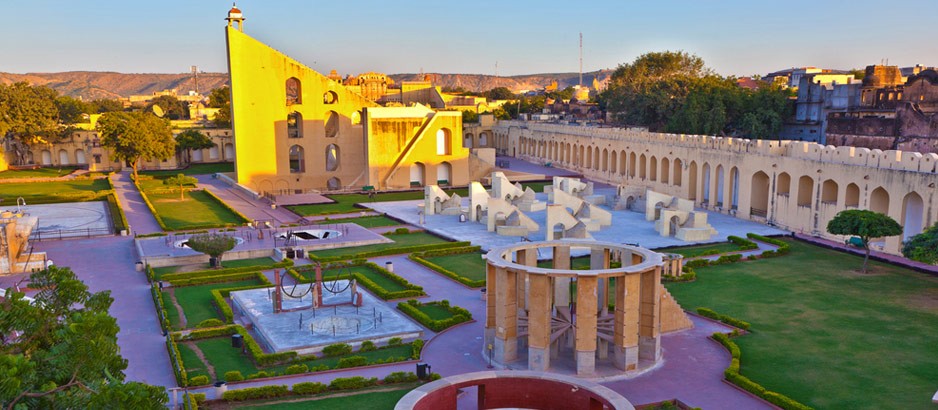Founded in AD 1727 by Sawai Jaisingh II, Jaipur the capital ofRajasthan is popularly known as the Pink Citywith broad avenues and spacious gardens. The capital of Rajasthan, Jaipur is steeped in history and culture. Here the past comes alive in magnificent forts and palaces, blushed pink, where once lived the maharajas. The bustling bazaars of Jaipur, famous for Rajasthani jewellery, fabric and shoes, possess a timeless quality and are surely a treasure-trove for the shoppers. This fascinating city with its romantic charm takes you to an epoch of royalty and tradition.
The imperial city, replete with amazing legends of romance and heroism. A land where the past thrives still. This is the fortified city of Jodhpur, standing a wary sentinel to the great Thar Desert. Beckoning you to the wilderness of fascinating dunes, rocky terrain and thorny vegetation.
Once the capital city of the Marwar state, it was founded in 1459 by Rao Jodhaji - chief of the Rathore Clan of Rajputs who claimed descent from Lord Rama. A major trade centre of 16th century, the city, today, has grown to become the second largest city of Rajasthan, retaining the medieval splendour.
The city is encompassed by a high wall, 10 km. long with eight gates. Within the city, atop a rocky hill, stands the massive fort, 120 mtrs. above the plains. Packed with history, art and culture, this princely state is a treasure - trove of some exquisite palaces, forts, temples and havelis - standing a testimony to the imperial grandeur. But what entices the most in Jodhpur is the traditional lifestyle, festivity and smiling people.
Major Attractions of Jaipur

The City Palace : In the heart of the old city is former royal residence built in a blend of the Rajasthani and Mughal styles. The carved arches are supported by grey-white marble columns ornate with floral motifs in gold and colored stones. Two carved elephants in marble guard the entrance. The retainers whose families have served generations of rulers serve as guides. The palace houses a museum with a superb collection of Rajasthani costumes and armory of Mughals and Rajputs. The palace also has an art gallery with an excellent collection of miniature paintings, carpets, royal paraphernalia and rare astronomical works in Arabic,Persian,Latin and Sanskrit, acquired by Sawai Jai Singh II to study astronomy in detail.
Govind Devji Temple : To the north of Chandra Mahal in the midst of the sprawling Jai Niwas Garden is the spireless temple of Lord Krishna. The idol wsa brought from Vrindavan and installed here by Sawai Jai Singh II as the tutelary deity. Today, the temple attracts devotees, from all over the country.
A delightful system of fountains is placed in the middle of the paved path between the Chandra Mahal and the Badal Mahal. The palace has extensive and sprawling gardens.
Amer Fort : At a short distance of 11 kms . from Jaipur, the Amer Fort complex stands amidst wooded hills overlooking the Delhi-Jaipur highway, with its forbidding ramparts reflected in the still waters of the Maota Lake below. One of the finest examples of Rajput architecture, it was the ancient capital of the Kachhawah rulers.
The original palace was built by Raja Man Singh and additions were made later by Sawai Jai Singh. Within the palace are the Diwan-e-Aam or the "Hall of Public Audience", the Diwan-e-Khas or the "Hall of Private Audience" and the Sukh Niws where a cool breeze blows across channels of water for the purpose of air-conditioning.
Hawa Mahal : The Hawa Mahal, or the "Palace of Wind" built by Maharaja Sawai Pratap Singh in 1799 A.D. is characterised by elaborate and fanciful architecture. The broad pyramidical facade comprises five storeys of semi octagonal overhanging windows with perforated screens, domes and spires.
Ram Niwas Garden Central Museum (Or Albert Hall Museum) : Situated in the spacious and beautiful Ram Niwas Garden, the museum has a rare collection of art facts and craft items such as metalwork, ivory carvings, cane wood articles and exquisite pieces of jewellery, textile, pottery and paintings. It is particularly rich in specimen of embossed, hammered and chiselled brass wares..
The building was designed by Colonel Sir Swinton Jacob in the modern Indo-Saracenic style and was built in 1886 A.D. when King Edward VII visited as the Prince of Wales.
Places to Stay in Jaipur
There are several budget hotels and paying guest accommodations available in Jaipur.
How to Get there

Air : Indian Airlines connect Jaipur with Delhi, Jodhpur, Udaipur, Aurangabad, Bombay, Varanasi, Calcutta, Ahmedabad.
Rail : Jaipur is connected by rail with Delhi, Agra, Ahmedabad, Ajmer, Abu Road (Mount Abu), Udaipur, Bombay and Sawai Madhopur.
Road : Good motorable roads connect Jaipur with Delhi 258 km, Agra 236 km, Bikaner 321 km, Udaipur 405 km, Ajmer 131 km, Jodhpur 316 km, Bharatpur 176 km, Jaisalmer 638 km and Bombay 1202 km .
Climate in Jaipur
Like most other north Indian cities, Jaipur too has extreme climate. The summers can be very hot with mercury crossing 45 degree, whereas winters are chilled and the temperature can fall below 5 degrees.




